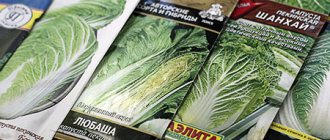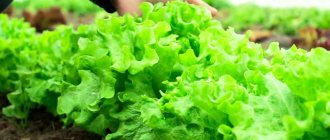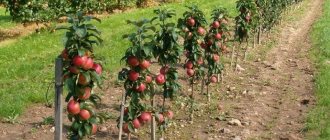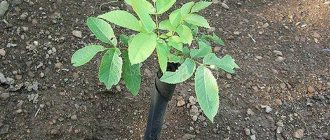Broccoli is a vegetable crop that is very beneficial for the body due to the huge amount of microelements it contains. Grow vegetables correctly with seedlings. And there is nothing problematic about this - cruciferous plants are easy to care for, the germination rate of the seed material of this plant is about 95%. In order for the vegetable crop to develop favorably and form a powerful healthy rhizome by the time it is transplanted into open ground, it is important to clarify the timing of planting. It is necessary to plant broccoli seedlings in 2021 according to the lunar calendar.
Planting and caring for broccoli
- Planting: sowing seeds for seedlings - in the first half of March, planting seedlings in the ground - in mid-May. Sowing is done by conveyor method every 2 weeks until mid-June, but from April the seeds are sown directly into the ground.
- Lighting: bright sunlight.
- Soil: almost any slightly alkaline or neutral soil.
- Watering: regular and sufficient, on average once a week, but in hot weather water more often. In the evenings in summer, it is advisable to spray the leaves with warm water.
- Feeding: regular: the first time - two weeks after planting the seedlings with a solution of a glass of mullein or chicken manure and a teaspoon of urea in a bucket of water; the second time - after another 2-3 weeks with ammonium nitrate (1 matchbox per bucket of water), the third time - with full mineral fertilizer two to three weeks after the second feeding. Wood ash can be used as an organic fertilizer.
- Reproduction: seed.
- Pests: cabbage whites and cutworms, slugs, snails, aphids, cruciferous flea beetles, cabbage flies.
- Diseases: blackleg, clubroot, alternaria, white rot, white and dry rot, peronospora, mosaic, vascular bacteriosis and fusarium.
Read more about growing broccoli below.
Broccoli - description
Externally, broccoli is the same as cauliflower, only its inflorescences are green, not cream. In the first year of growth, the broccoli stem reaches 60-90 cm in height, and at its top numerous succulent flower stalks are formed, which are crowned with dense groups of green buds collected in a loose small head. This head is eaten without waiting for the flowers to form. If the buds turn yellow, the cabbage is no longer suitable for eating. After the head is cut off, new inflorescences form from the side buds of the broccoli. Thus, cabbage bears fruit for several months.
In recent years, the broccoli vegetable has become no less popular than white cabbage, beets, carrots, red cabbage and other crops traditionally grown in our gardens. We will share with you information on how to grow broccoli from seeds, how to process the seeds before sowing, how to plant broccoli for seedlings, how to grow broccoli seedlings and how to grow broccoli in the garden, as well as what varieties of asparagus cabbage are popular among gardeners and what are the benefits broccoli.
Harvesting
Depending on the variety, the first harvest of broccoli comes out 12-16 weeks after sowing the seeds. The varietal affiliation is determined by whether one head will ripen or whether additional side heads will also delight with their taste.
Do not wait until the maximum size of the head, otherwise it may become overripe and lose its taste. Cut broccoli in the morning so that the head is saturated with juice as much as possible.
Loose heads contain less nutrients, but their cooking time is much shorter. Dense broccoli inflorescences require longer temperature treatment, but they also contain much more vitamins and minerals.
The first cut heads are stored in the refrigerator for about a week. They can be frozen for the winter by disassembling them into inflorescences. The side heads and late varieties of this cabbage are best suited for canning and storage in cellar conditions at a temperature of about 0 degrees.
To clean the bed after harvesting, leave the plant debris pulled out of the ground on the surface. After a few weeks, they form small heads of broccoli, edible and very tasty.
Growing broccoli is not difficult and does not require special equipment or knowledge. A minimum of material costs and a little time for responsible implementation of the necessary agricultural work will bring joy from a generous harvest of healthy and tasty cabbage.
0
0
Copy link
Growing broccoli from seeds
Sowing broccoli seeds - when to sow
Growing broccoli from seeds begins in the first half of March - this is when broccoli seeds are sown for seedlings. You can sow broccoli seeds using a conveyor belt method, at several intervals every two weeks until mid-June, but from the end of April, broccoli is planted directly into the ground without seedlings. Sowing late-ripening varieties of broccoli in areas with short and cool summers is risky - they may not have time to ripen, so in such areas it is better to grow mid-season or early cabbage.
- Hawthorn: growing in the garden, properties, types
Growing broccoli seedlings
Before sowing, the seeds are sorted, selecting the largest ones for cultivation, kept in hot water (50 ºC) for 15-20 minutes, and then immediately immersed in cold water. Then the seed material is immersed in Epin’s solution for 12-15 hours, then washed well under running water, kept in the refrigerator for a day and dried until flowable.
Broccoli is planted in a box 25 cm high, on the bottom of which a layer of drainage material is first laid, and then a neutral or slightly alkaline substrate is poured, consisting of turf soil, sand, ash and humus - the soil for broccoli should be loose and permeable to water. In a well-moistened substrate, make grooves 1-1.5 cm deep at a distance of 3 cm from each other, throw seeds into them, seal them and lightly compact the soil.
Broccoli seedlings are grown in the same way as white cabbage seedlings. Before emergence, the temperature in the room where the broccoli seedlings are located should be about 20 ºC, but after emergence it is lowered to 10 ºC for a week, after which the following temperature regime is set: on sunny days - 16 ºC, at night - 9 ºC, cloudy days – 14 ºC. Air humidity should be high, and the soil should be slightly moist all the time. Prolonged waterlogging can lead to seedlings becoming infected with blackleg.
Broccoli pick
When the seedlings are two weeks old, the seedlings are picked. It is best to plant them in peat pots, in which you will then transplant the seedlings into the garden bed. After picking, broccoli seedlings need to be protected from the sun for several days by constructing a paper shelter, and the room temperature should be increased to 21 ºC. When the seedlings take root, feed the seedlings with fertilizers that include microelements such as molybdenum and boron, and keep them at a temperature of 17 ºC during the day and at 9 ºC at night. Two weeks before planting seedlings in open ground, hardening procedures are carried out on them.
Site selection and soil preparation
Broccoli is an unpretentious plant, but it has preferences. This Mediterranean guest loves well-lit areas; in the shade, cabbage grows poorly and produces small heads. It takes root well in neutral and slightly alkaline soil. Preparations should begin in the fall, if you already know where you will plant broccoli next year, then:
- Good quality ash (after wood, no coal or plastic), dolomite flour, lime, or something from this series is added to the soil, then dug up, adding humus.
- Let’s say you didn’t prepare the soil in the fall, then a month before planting the seedlings, they lime the soil.
- Immediately before planting, fertilize the beds with well-rotted compost or rotted manure, 1 bucket per 1 sq. m.
Broccoli in the garden
Planting broccoli in open ground
When to plant broccoli in the ground
Broccoli seedlings are grown at home for 35-45 days until the seedlings develop 5-6 true leaves, after which they are planted in the garden. Usually the time comes in mid-May, but if the soil in the garden has not warmed up enough or there are still frosts at night, you should not rush to plant.
Choose a sunny site for broccoli. The best predecessors for it are green manure, carrots, onions, grains, cucumbers, potatoes and legumes. You should not plant broccoli after any cabbage and vegetables such as beets, radishes, tomatoes, turnips or radishes - after these crops it is permissible to plant broccoli on the site only after four years.
Soil for broccoli
The soil for broccoli should be neutral or slightly alkaline - pH within 6.7-7.4 units. Soil preparation on the site begins in the fall: manure or compost is added for digging at the rate of 4-5 kg per m². If the soil on the site is acidic, add lime to it.
How to plant broccoli in open ground
Broccoli seedlings are planted according to a 35x60 cm pattern on a cloudy day or in the evening. Add 5-10 g of complete mineral fertilizer to each hole, mix it well with the soil, then lower the seedlings into the hole, sprinkle it with soil, compact it and water it. If you are afraid of return frosts, cover the seedlings with film, because at a temperature of -2 ºC they may die.
Growing broccoli in open ground also involves sowing seeds directly into open ground when the threat of return frosts has passed - in early or mid-May. Seeds should be processed before planting, as we have already described in previous sections. When the seedlings appear, they are thinned out to increase the feeding area for the seedlings. If you don’t want to bother with thinning, sow broccoli according to a 30x50 cm pattern.
Proper care: several secrets of a good harvest
There is a nuance in caring for broccoli in open ground. In too hot weather, you need to create artificial shading. To create the humid atmosphere that cabbage loves, place containers with water near the beds, and you can spray the plant.
Watering and mulching the soil
Water the plant frequently and abundantly after planting, during rooting in a new place. Then watering is reduced, making sure that the soil does not dry out. During the development of cabbage heads, watering is increased again.
Young plants need mulch after planting to retain moisture. In addition, mulch will prevent the development of weeds and overheating of the root system in the soil.
Weeding and loosening the soil
After each watering, loosening is carried out, the soil should be saturated with oxygen.
Moisture in loose soil is better absorbed and delivers nutrients to the roots of the plant. Many summer residents hill up cabbage to form additional lateral roots. This will make the plant stronger.
If weeds appear, they need to be removed. Be careful not to damage the root system of the plant during weeding.
Feeding broccoli
After planting, the cabbage is fed by adding mullein infusion (1 part mullein to 10 parts water). You can add an incomplete spoon of urea to the infusion.
The second feeding is carried out after 14 days. Slurry (1 to 4) is applied at the root.
The third time the plant is fertilized during the formation of inflorescences. Prepare a superphosphate solution: 2 tbsp. l. for 10 liters of water, the solution is enough for 10 plants.
The last feeding is carried out after cutting the head.
When applying fertilizers, watch the plant - by its appearance you can understand what elements it lacks. With a lack of nitrogen, cabbage grows poorly, the lower leaves turn yellow and dry out. If there is little potassium, the leaves change color to reddish, their edges dry out, and the cabbage heads do not gain weight.
How to Grow Broccoli
Broccoli care
Growing and caring for broccoli is almost the same as cultivating cauliflower: you will have to loosen the soil in the garden bed, fight weeds, water and feed the cabbage. Twenty days after planting, and then another ten days later, broccoli bushes in the garden are earthed up, loosening the soil in the root zone.
The peculiarity of cabbage seedlings is that at an early stage of development they are afraid of the scorching sun, and you will have to protect them from it by covering them with spruce branches or old buckets. In addition, when the real heat sets in, you will need to not only water the broccoli, but also humidify the air around it - the more often, the better. Loosening of the soil in the root zone of cabbage is carried out to a depth of 8 cm. It is most convenient to loosen the area and weed the broccoli in the country one day after watering.
Watering broccoli
On average, broccoli in open ground is watered once a week, but when the air temperature rises above 25 ºC, it may be necessary to moisten more often - it should be regular and sufficient, but you should not turn the soil in the area into liquid mud. And remember that you can water the plant not only through the roots, but also through the leaves - spray them in the evenings.
Feeding broccoli
Growing and caring for broccoli involves regular feeding of the plant. The first time cabbage is fertilized two weeks after planting the seedlings in the ground with a solution of mullein at the rate of 1 glass of organic matter per bucket of water. A teaspoon of urea should be added to the prepared solution. Instead of mullein, you can use chicken manure by dissolving one part of it in 20 parts of water. If you sowed the seeds directly into the ground, then fertilizers can be applied no earlier than three weeks after the emergence of seedlings.
- Jerusalem artichoke: growing in the garden, types and varieties
The second feeding is carried out with saltpeter 2-3 weeks after the first feeding. Dosage – 1 matchbox of saltpeter per full bucket of water. At the end of summer, broccoli's need for nitrogen decreases, but the need for potassium-phosphorus fertilizers arises. For the third feeding, 40 g of superphosphate, 20 g of ammonium nitrate and 10 g of potassium sulfate are diluted in 10 liters of water.
After cutting the central head, fertilizer is applied to stimulate the growth of side shoots: 10 g of ammonium nitrate, 20 g of superphosphate and 30 g of potassium sulfate are diluted in 10 liters of water. 1 liter of liquid fertilizer is poured under each bush.
Broccoli is also fed with wood ash, scattering it over the area in the amount of 1 cup per m².
Growing broccoli in the Moscow region
Readers have asked whether broccoli, which grows well in warm areas, can be grown in areas with short, cool summers. The high cold resistance of the crop makes it possible to grow broccoli in areas with cold climates. Broccoli is successfully cultivated in the Moscow region, the Urals and even in Siberia. Moreover, from the more than two hundred varieties of this type of cabbage existing today, you can choose the most cold-resistant forms and hybrids.
Temperature, humidity and soil requirements
Broccoli requires light and moisture. Recommended soil humidity is 75%, air humidity is 85%. The vegetable is not very sensitive to high and low temperatures: it tolerates frosts down to -7 ºC and does not require shading of the head. The optimal temperature range is 16-25 ºC.
The culture prefers loose, slightly alkaline and neutral soils. It is recommended to grow it in areas where potatoes, carrots, and legumes were located last year. Bad predecessors are radishes, turnips, radishes, cabbage, and tomatoes. It is not recommended to plant broccoli in the same areas earlier than after 4 years.
Pests and diseases of broccoli
Broccoli pests
Growing broccoli can be complicated by pest control, of which cabbage, unfortunately, has many. Despite its resistance to parasitic insects, it can sometimes be bothered by aphids, cruciferous midges, cabbage flies, white butterflies and cutworms, as well as snails and slugs.
Aphids are a very common pest that can destroy any plant. Colonies of aphids cover the stems, leaves and inflorescences of broccoli, secreting a waxy substance on them. The leaves become discolored, acquire a pinkish tint and curl. Aphids reproduce very quickly - in one season they produce up to 16 generations, which tirelessly carry out their destructive activities.
The cabbage fly is not as dangerous in itself as its larvae, which damage all cabbage plants and vegetables such as radishes, rutabaga and turnips, are dangerous. Moreover, both adult specimens and seedlings suffer from them. The larvae make their way to the roots of plants, eat them and gnaw tunnels in the stems of plants.
The cruciferous flea beetle and its larvae eat holes in cabbage stems, after which the plants dry out and die. In addition to cabbage plants, these flea beetles also damage horseradish, watercress, daikon and turnips.
The cabbage white butterfly, or cabbage butterfly, lays eggs on the ground parts of cruciferous crops, from which caterpillars emerge that eat the leaves of the plants mainly at the edges.
The cabbage cutworm is a nocturnal moth whose caterpillars damage almost all types of cabbage, as well as onions, lettuce and peas.
Slugs and snails eat the leaves of large cabbage plants, leaving holes in them, and destroy small bushes completely.
Broccoli processing
You can get rid of aphids in various ways: if there are only a few of them, simply crush them on the cabbage leaves, but if the number of aphids is significant, treat the broccoli with an infusion of potato tops or an ash-soap solution. If spraying with plant insecticides does not help, you can always purchase preparations such as Iskra-bio or Actellik, for example, and use them to treat plants according to the instructions.
The cabbage fly is destroyed by spraying broccoli with one percent solutions of Ambush or Rovikurt; Corsair and Anometrine also cope well with the problem.
The cruciferous flea beetle can be repelled with tansy or celandine powder, scattering them between the rows. In advanced cases, you will have to turn to one percent solutions of Actellik or Foxim.
- Bacopa: growing from seeds, types and varieties
Treatment of broccoli with Ambush, Belofos, Talkord, Anometrine, Rovikurt, Foxim and other similar drugs is effective against cabbage and cutworms in accordance with the instructions.
Broccoli is protected from slugs and snails using agrotechnical methods: make grooves around the perimeter of the bed, pour one of these powders on their bottom: lime, tobacco dust, ground hot pepper or wood ash - this will become an insurmountable barrier for gastropods on the way to the area with cabbage.
In addition to the described pests, under certain conditions, broccoli can be affected by boletus, wavy and black flea beetles, harmful centipede, cabbage moth, cabbage moth, cabbage and rapeseed bugs, root and rapeseed bugs, mole crickets, cutworms, winter and gamma, rapeseed flower beetle, tobacco thrips and dark nutcracker.
The use of chemical and biological preparations is justified only in cases of massive insect infestation, when it is urgently necessary to save the crop. How to grow broccoli without using products harmful to plants and the environment to protect it? The main thing is compliance with the agricultural technology of the crop, as well as strict implementation of care measures that cannot be neglected: pre-sowing treatment of soil and seeds, weeding throughout the season, mandatory autumn digging of the site, removal of plant residues from the bed at the end of the season.
Features of care
Correct and timely watering significantly increases the yield of vegetable crops
How to grow broccoli without much hassle? Caring for the “Italian” includes traditional gardening chores. It is necessary to place special emphasis on watering and controlling pests and diseases, since the tender leaves and tasty heads attract the attention of not only people.
In general, the vegetable adapts well to the continental climate of the Russian expanses, stoically enduring heat and cold, winds and sudden changes in weather. It is unpretentious and quite suitable for growing in Russian open spaces.
Biological features:
- Illumination . Grows well in a bright, open place. In poor lighting, loose and small heads form, so it is best to position the bed from east to west
- Temperature regime . Feels great in a moderate range from +16 to +20C. At elevated temperatures, the heads become loose and flower shoots appear. Withstands light frosts: -2C (young plants) and -7C (adult plants)
- Watering and air humidity . Optimal soil moisture is 70% and air moisture is 80%. This regime can be created by sprinkling. In its absence, regular watering is necessary so that moisture penetrates to a depth of 15-20 cm, otherwise the asparagus cabbage will go to waste. On average, watering is carried out every other day, but it all depends on weather conditions. Automatic watering is convenient, which automatically waters deep layers of soil. It is useful to moisten the foliage and spray it
- Soils . These are light, moisture-intensive, nutrient-rich formulations with neutral acidity. Deep topsoil guarantees good root growth
- Weeding and loosening . Held regularly. Allows you to destroy the soil crust and get rid of a number of pests that readily move from weeds to cabbage
- Feeding . A minimum of three feedings are recommended, aimed at the growth of the ground part and the formation of the head. When the central part is cut off, the growth of the lateral parts is stimulated with the help of fertilizers.
- Hilling up . When the inflorescence begins to form, hilling is carried out, raking a layer of earth under the bush. This stimulates the growth of additional roots.
Growing Broccoli
Do not pull out the plant after removing the main head. It will take some time for the lateral inflorescences to appear from the axillary shoots. This will bring additional harvest. Their development and formation do not require shading, like cauliflower.
Broccoli diseases
Growing broccoli in open ground is sometimes complicated by the crop's susceptibility to diseases such as blackleg, clubroot, Alternaria, white rot, white and dry rot, downy mildew, mosaic, vascular bacteriosis and fusarium.
Blackleg is a disease that primarily affects broccoli seedlings, softening the necks of the seedlings, causing them to turn black, and their stems become thinner and lie down.
Ways to fight. Caring for seedlings involves timely thinning of seedlings. It is very important not to allow the soil to become waterlogged. Diseased plants must be removed, and the soil should be spilled with a pink solution of potassium permanganate (3-4 g of potassium permanganate per 10 liters of water), after which the seedlings should not be watered for a week. For preventive purposes, plants are sprayed with Fitosporin, Baktofit, Fitolavin-300 or Planriz.
Clubroot forms oval or spherical growths on broccoli, which become brown and begin to rot as the disease progresses. Specimens affected by clubroot begin to wither and look underdeveloped.
Ways to fight. You will not be able to cure diseased plants, but you can prevent infection of future crops: plant nightshade crops (potatoes, eggplants, tomatoes, physalis or peppers) in the area after broccoli, and in three years they will clear the soil of clubroot pathogens, and onions, chard, garlic, spinach and beets will do this in two years.
Belle forms a coating similar to spots of oil paint on the stalks, leaves, stems and seeds of diseased plants. As the disease progresses, these parts become brown and dry, and the leaves swell and bend.
Ways to fight. Diseased bushes should be removed immediately, and the remaining plants should be treated with copper-containing preparations. A preventive measure is compliance with crop rotation, as well as weed control.
Alternaria blight appears as small brown necrotic spots on the above-ground parts of broccoli. Over time, they grow and transform into concentric brown spots covered with fungal spores. The disease is transmitted by insect pests.
Ways to fight. Before sowing, warm the seeds for 20 minutes in hot water, as described above. Observe the agrotechnical conditions of the crop - weed the beds and remove plant debris from them in the fall.
Downy mildew, or downy mildew, covers broccoli leaves with yellowish spots, on which a white coating forms from the bottom of the leaf blades.
Ways to fight. As a preventive measure, carry out pre-sowing treatment of seeds, and pollinate the affected seedlings three times at weekly intervals with wood ash, ground sulfur or a mixture of lime and sulfur. In case of severe damage, treat the broccoli with a solution of one ampoule of Topaz in 10 liters of water.
White rot manifests itself on broccoli in different ways: cobwebs on the underside of the leaf blade, rotting of the stems. The most common source of infection is acidic soil, oversaturated with nitrogen, and infection usually occurs in cool weather.
Ways to fight. To combat the disease, plants are treated with preparations containing copper, and prevention involves observing crop rotation, liming acidic soils, timely weeding and removing plant debris from the site.
Dry rot is identified by pale spots with black dots on the leaves of broccoli, and the stem behaves in the same way as with blackleg disease - plant growth slows down, their tissues are destroyed, and dry areas form on them.
Ways to fight. The same measures are effective against dry rot as for downy mildew in broccoli.
The mosaic first appears as barely noticeable spots on the interveinal area. As the disease progresses, the leaves become deformed, a dark green border appears on them, and the leaf blade becomes covered with light-colored necrotic spots.
Ways to fight. It is useless to treat viral diseases; affected specimens should be immediately dug up and burned. As a preventative measure, regularly remove weeds from the garden bed and prevent aphids or other harmful insects that carry mosaic pathogens from settling on the broccoli.
Vascular bacteriosis can be identified by the yellowing edges of the leaves, which gradually become parchment-like to the touch, the veins on the leaves darken, and the affected parts of the plants die.
Ways to fight. Treat broccoli with biological preparations Planriz or Trichodermin as written in the instructions. Warm up the seeds before sowing, observe crop rotation and do not leave leftover broccoli on the plot until spring.
Fusarium wilt, or tracheomycosis, turns broccoli leaves yellow-green, sometimes on only one side. Leaves become lethargic, develop unevenly, become deformed and fall off.
Ways to fight. An effective measure is to treat broccoli with fungicides from the group of benzimidazoles, and as a preventive measure, it is necessary to adhere to agricultural practices and immediately remove diseased specimens from the garden with their subsequent destruction.
Growing broccoli in open ground if not properly cared for will almost certainly be complicated by some of the diseases described above, but caring for broccoli is not that difficult, and following the rules for cultivating this crop can save you not only from broccoli diseases, but also from its pests.
Types and varieties of broccoli
Broccoli is superior to our beloved cauliflower in many ways:
- she is not afraid of cold weather;
- it is quite resistant to pests;
- broccoli has high yield and remontant ability;
- it is undemanding to growing conditions;
- In addition to broccoli inflorescences, you can also eat its young shoots up to 15 cm long.
Broccoli is found in two varieties: the familiar calabrese form with a dense inflorescence on a thick stem and Italian, or asparagus broccoli, which forms many stems with small inflorescence heads. And in total, as we have already written, there are about 200 varieties of broccoli. According to the ripening period, varieties are divided into early, mid-ripening and late. We offer you the best varieties of broccoli that you can grow on your site.
The most popular early ripening varieties are:
- Tonus is one of the most delicious and productive varieties of broccoli, ripening from 70 to 90 days, with a large dark green head of medium density weighing up to 200 g. After cutting the central inflorescence, lateral shoots weighing 50-70 g quickly grow;
- Broccoli F1 is a medium-yielding hybrid with a large, medium-density malachite green head. This cabbage is consumed both fresh and processed;
- Linda – This medium-height broccoli variety matures in 95 days. The average weight of the head is 300-400 g, the lateral shoots reach 70 g. The Linda variety is used for fresh eating, canning and freezing;
- Vitamin-rich - this broccoli will ripen from 72 to 90 days, it has a dense dark green central head weighing from 130 to 250 g. One and a half to two weeks after cutting the central head, lateral inflorescences with a diameter of 4-5 cm grow;
- Curly head is a variety resistant to major diseases and unfavorable climatic conditions with a dense green head weighing up to 600 g, ripening in 80-95 days. After cutting the main inflorescence, cabbage of this variety quickly forms many lateral heads. The variety is suitable for long-term storage.
In addition to those described, you can try to grow such early varieties of broccoli on your site as Summer King, Comanche, Green Sprouting, Vyarus, as well as hybrids Emperor, Corvette, Laser, Tribute and Fiesta.
The best mid-season broccoli:
- Senshi is a tall variety that ripens in approximately 110 days with a large, hard, dome-shaped head of dark green color, suitable for long-term storage;
- Compacta is a compact variety that ripens approximately 100 days after sowing, with a dome-shaped central head of dark green color. The variety is suitable for dense planting;
- Calabrese - this variety of cabbage ripens within 90 days. The heads of broccoli of this variety are medium dense, dark green in color, weighing up to 400 g, 6-7 side heads reach a weight of 100 g;
- Greenia is an extremely productive variety, forming a rosette of leaves up to 60 cm high and a central head weighing up to 300 g;
- Atlantic - the height of the stem of this variety is 50-60 cm, the heads are large and dense - the central one weighs up to 400 g.
Varieties and hybrids of mid-season broccoli Arcadia, Balboa, Genoa, Greenbelt, Gnome, Green Favorite, Monton, Fortuna and Caesar are also popular in cultivation.
Late broccoli is represented by the following varieties:
- hybrid Lucky - a variety with a large and dense central head weighing up to half a kilogram, green color and delicate structure;
- the Monterrey hybrid is a productive variety with a large central head weighing up to 500 g, but this broccoli does not produce lateral shoots;
- Continental - the central head of this variety is also dense and large - reaches a weight of 500 g;
- hybrid Marathon - these plants have a raised rosette of leaves, the central head is dense, green, with a delicate texture, weighing up to 700 g.
Brief characteristics of vegetable crops
Broccoli belongs to the Cruciferous family
It originates from the Mediterranean, but its pedigree is not known for certain. It was obtained in Italy by simple selection several centuries ago, when there was no idea about selection.
It is genetically close to cauliflower, which was bred by hybridization from broccoli. Although some botanists claim that it was the other way around.
They are similar in appearance and form inflorescences collected in a head. The cauliflower inflorescences are very dense, while the broccoli are looser.
Modern broccoli has 200 varieties that have spread throughout the world. Such abundance and growing needs indicate its value as a dietary and vitamin product.
Biological characteristics of vegetable crops:
- the stem grows up to 60-90 cm;
- bush large, spreading;
- at its top peduncles with small, green buds are formed, which are edible;
- buds of small flowers form a head of green, blue or emerald color;
- the inflorescence head differs in shape, forming conical and round outlines;
- forms additional flower stalks on side shoots;
- has a different weight (150-700 g and even 1 kg), which is influenced by the variety;
- the leaves are large, whole and slightly corrugated, located on long petioles;
- characterized by cross-pollination;
- main varieties: capitate and stem;
- the growing season lasts from 50 to 150 days, which depends on the speed of ripening of the variety.
There are winter and spring varieties. In the regions of Russia, spring broccoli with a green head is most often grown. This is a hybrid variety that belongs to the Italian green branched variety.
Early varieties form lateral heads simultaneously with the central one. In later ones, they are formed after cutting the central one. The ability to form heads on stepsons significantly increases productivity, lengthening the growing season.
Properties of broccoli - harm and benefit
Beneficial properties of broccoli
Since ancient Rome, broccoli has been considered the queen of cabbage due to its beneficial properties. It contains B vitamins, vitamins E, A, PP, K, C and U. Broccoli contains even more vitamin C than lemons and oranges, and vitamin U, which is no less in broccoli than in asparagus, is excellent promotes healing of ulcers. In addition to vitamins, broccoli contains macro- and microelements such as potassium, calcium, magnesium, sodium, manganese, phosphorus, iron, zinc, selenium and copper.
Broccoli is rich in beta-carotene, chlorophyll, fiber, amino acids, protein containing isoleucine and lysine, as well as choline and methionine, which prevent the accumulation of cholesterol in the body.
All these vitamins and elements are vital for humans, and in broccoli they are found in the most digestible form for the body. The undoubted benefit of broccoli is that it is an indispensable product for diabetics, since its components normalize insulin levels in the body and protect the walls of blood vessels from damage resulting from high blood sugar. Doctors advise people who have suffered from radiation or live in areas with high background radiation to regularly eat broccoli, as it has the ability to remove toxins, heavy metal ions and free radicals from the body.
Broccoli also helps relieve swelling that accompanies cellulite, and if you include this tasty and healthy product in your diet, your skin will gradually become smooth and toned.
As a result of recent medical research, scientists have found that broccoli, due to the content of sulforaphane, which inhibits the development of cancer cells, is very effective in the fight against diseases such as skin, breast and ovarian cancer, bladder and prostate cancer. This valuable substance is contained not in the inflorescence, but in the shoots and stems of broccoli. In those patients who ate broccoli at least twice a day, tumor growth stopped.
Broccoli - contraindications
Do not use broccoli when preparing vegetable broths, since when cabbage is cooked, substances adenine and guanine that are harmful to humans are released into the water. In addition, prolonged boiling, as well as baking in a microwave oven, destroys most of the beneficial substances contained in broccoli. It is not recommended to fry cabbage in a large amount of fat over high heat, since carcinogens are formed during the frying process, and this makes the product that is supposed to heal become harmful.
In order not to harm yourself from broccoli, it is necessary to eat it fresh or properly prepare it, however, people with high stomach acidity or impaired pancreatic function are not recommended to eat it at all. Postoperative patients also need to be very careful when including broccoli in their diet, since during this period, raw vegetables containing coarse fiber may be too heavy for the body. For those who are healthy but want to become even healthier, we offer several healthy and tasty broccoli dishes.
Casserole. Boil 200 g of broccoli in salted boiling water for a couple of minutes, drain in a colander and dry. 200 g of ham cut into strips. Whip 100 g of cream with egg white. The mold is greased with vegetable oil, broccoli is placed in it, ham is placed on top of it, everything is filled with whipped egg whites, salt to taste, sprinkled with any herbs and grated cheese in the amount of 100 g and baked in the oven at 180 ºC.
Broccoli soup. 400 g of the product is washed, the head is disassembled into small inflorescences and boiled for 2-3 minutes in salted boiling water with any spices. Separately, 30 g of almonds are poured with boiling water for 20 minutes, then peeled, ground in a blender, boiled broccoli is added to the almonds and, gradually pouring in the broth left over from cooking the broccoli, grind the mixture to a puree consistency, add a teaspoon of vegetable oil and 10 g walnut oil. Before serving, sprinkle the soup with sesame seeds.











